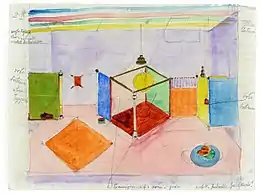Das Nusch-Nuschi
Das Nusch-Nuschi (The Nusch-Nuschi), Op. 20, is an opera in one act by Paul Hindemith, with a German libretto by Franz Blei.
| Das Nusch-Nuschi | |
|---|---|
| Opera by Paul Hindemith | |
 Oskar Schlemmer's stage design | |
| Description | A play for Burmese marionettes |
| Librettist | Franz Blei |
| Language | German |
| Premiere | |
Subtitled A Play for Burmese Marionettes in One Act (Ein Spiel für burmanische Marionetten in einem Akt), it is a staged work with both singers and dancers. It is the second work in a triptych of expressionist one-act operas, the others being Mörder, Hoffnung der Frauen and Sancta Susanna. They are the first operas written by Hindemith.[1] The first two were premiered together at the Württembergisches Landestheater in Stuttgart on 4 June 1921; all three were performed at the Oper Frankfurt in 1922.
History
Das Nusch-Nuschi was the second piece in a triptych of one-act operas by Hindemith influenced by Expressionism. Hindemith experienced World War I as a soldier in Belgium and Northern France. In a second wave of expressionism after the war, he became interested in the movement. It was a period of changes in society. Hindemith describes: "the old world exploded".[2]
Das Nusch-Nuschi is based on a 1904 play by Franz Blei, subtitled "A Play for Burmese Marionettes".[3] Blei was a Wagner enthusiast when he was young, but turned to contributing to the satirical weekly Simplicissimus and wrote plays for the cabaret Die Elf Scharfrichter (The Eleven Executioners), founded in Munich and focused on puppet satire. He had his Nusch-Nuschi reprinted in 1913 in an issue of Die Aktion that was dedicated to his work.[4]
While Mörder, Hoffnung der Frauen deals with brutality between the sexes, Das Nusch-Nuschi is in a way even "more subversive"[3] as it ridicules brutality and intense emotions.[5]
Roles
| Role | Voice type | Premiere cast, 4 June 1921[6] Conductor: Fritz Busch |
|---|---|---|
| Rag-weng | reciter | |
| the Nusch-Nuschi, a mythological beast | mime | |
| Zatwai, seducer of the emperor's 4 wives | mime | |
| Tum Tum, Zatwai's servant | tenor buffo | Heinrich Lohalm |
| Mung Tha Bya | bass | Albin Swoboda Jr. |
| Kyce Waing, an army chief | bass | Reinhold Fritz |
| Bangsa | soprano | Erna Ellmenreich |
| Osasa | soprano | |
| Ratasata | soprano | |
| Twaise | contralto | |
| Susulü | tenor | Felix Decken |
| Kamadewa | tenor | |
| Master of ceremonies | bass | |
| Executioner | bass | |
| Beggar | bass | |
| First dancer | soprano | |
| Second dancer | soprano | |
| First maiden | soprano | |
| Second maiden | soprano | |
| Third maiden | contralto | |
| First poet | tenor | |
| Second poet | bass | |
| First herald | bass | |
| Second herald | tenor | |
| First monkey | tenor | |
| Second monkey | tenor | |
Music
He composed the work in 1920 and finished it on 14 August of that year. It is playful with elements of slapstick comedy, in contrast with the other two pieces of the triptych. The opera is in the tradition of commedia dell'arte with its stereotype characters. It is a satire on European drama and opera. Hindemith uses traditional musical forms, often in parody. A quote from Wagner's Tristan und Isolde, Marke's "Mir dies!", was regarded as a sacrilege by some of Hindemith's contemporaries. Hindemith comments the third dance: "The following 'choral fugue' (with all mod cons: augmentation, diminutions, stretto and basso ostinato) simply thank their existence to an unfortunate coincidence: they were conceived by the composer. They have no further purpose than this: to incorporate themselves stylishly into the framework of this picture and provide all 'experts' with the opportunity to bark about the incredibly bad taste of their creator. Hallelujah! – It is essential that this piece be danced (or rather wobbled to) by two eunuchs with incredibly fat and naked bellies."[7]
Hindemith also quotes from Till Eulenspiegel by Richard Strauss, and parodies the exotic sounds of Mahler’s Das Lied von der Erde, using celesta, mandolin, harp and English horn. He contrasts tender music with "the screeches of two trained monkeys", and parodies the "neo-Baroque" style of Max Reger with a grotesque "choral fugue".[2]
Performances
The opera was first performed, together with Mörder, Hoffnung der Frauen, on 4 June 1921 at the Württembergisches Landestheater in Stuttgart,[8] conducted by Fritz Busch and staged by Otto Erhardt. The artist Oskar Schlemmer was responsible for the stage set, costums and choreography.[7] The duration is given as 60 minutes.[7]
References
- Kingsbury.
- Schubert 2004.
- Haney 2008, p. 340.
- Haney 2008, p. 343.
- Haney 2008, p. 339–340.
- Casaglia 2005.
- Schott 2017.
- Skelton 1992.
Sources
- Casaglia, Gherardo (2005)."Das Nusch-Nuschi, 4 June 1921". L'Almanacco di Gherardo Casaglia (in Italian).
- Haney, Joel (Fall 2008). "Slaying the Wagnerian Monster: Hindemith, Das Nusch-Nuschi, and Musical Germanness after the Great War". The Journal of Musicology. University of California Press. 25 (4): 339–393. doi:10.1525/jm.2008.25.4.339. JSTOR 10.1525/jm.2008.25.4.339.
- Kingsbury, Stephen. Paul Hindemith – Compositions at AllMusic
- Schubert, Giselher (2004). "Hindemith's Opera Trilogy". American Symphony Orchestra. Retrieved 7 March 2017.
- Skelton, Geoffrey (1992). "Das Nusch-Nuschi". In Sadie, Stanley (ed.). The New Grove Dictionary of Opera. London. ISBN 0-333-73432-7.
- "Das Nusch-Nuschi / Ein Spiel für burmanische Marionetten in einem Akt / Text von Franz Blei". Schott Music. Retrieved 7 March 2017.
External links
 Media related to Das Nusch-Nuschi at Wikimedia Commons
Media related to Das Nusch-Nuschi at Wikimedia Commons- Das Nusch-Nuschi: Scores at the International Music Score Library Project